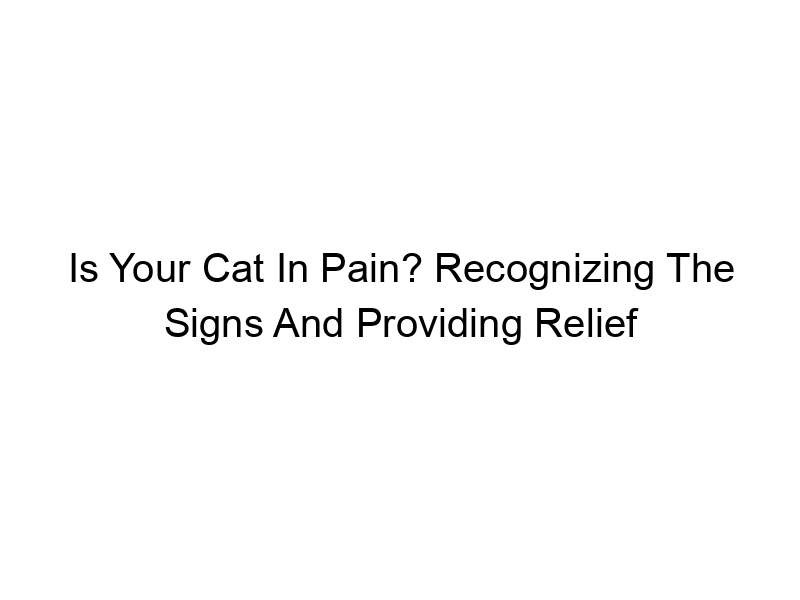Is your feline friend acting a little different lately? Understanding the subtle and not-so-subtle Signs Your Cat is in Pain and How to Help is crucial for ensuring their well-being. This comprehensive guide will equip you with the knowledge to recognize pain indicators in cats, understand the underlying causes, and learn how to provide appropriate care and support. We’ll explore various symptoms, from the obvious to the easily missed, and guide you through seeking professional veterinary assistance. You’ll learn about different pain management strategies, and how to create a supportive environment for your beloved pet.
Cats, masters of disguise, are experts at hiding pain. This instinct, stemming from their wild ancestry, makes recognizing their discomfort a challenge for even experienced pet owners. Understanding feline pain requires careful observation and awareness of their normal behavior. Unlike humans
who can verbally express their pain, cats rely on behavioral and physical changes to signal distress.
Common Signs of Pain in Cats
Identifying pain in cats often involves recognizing subtle changes in their behavior and physical appearance. These changes can manifest in various ways, requiring a keen eye for detail. Some common signs include:
- Lethargy and decreased activity
- Changes in appetite – either increased or decreased food intake
- Vocalization – meowing more than usual, hissing, or yowling
- Changes in grooming habits – excessive grooming or neglecting grooming altogether
Physical Manifestations of Pain
Changes in Posture and Gait
Observe your cat’s posture and gait. Limping, stiffness, difficulty jumping, or reluctance to move are strong indicators of pain. A hunched posture, tucked tail, or avoiding certain movements can also signify discomfort.
Changes in Litter Box Habits
Pain can affect a cat’s ability to use the litter box effectively. Straining, crying while urinating or defecating, or accidents outside the box may indicate underlying pain, especially in the urinary or gastrointestinal tract.
Respiratory Distress
Pain can manifest as difficulty breathing. Observe your cat’s breathing rate and pattern. Rapid, shallow breathing, or open-mouthed breathing could indicate pain or a more serious underlying condition. This may be particularly apparent if your cat also exhibits difficulty moving.
Behavioral Indicators of Pain
Aggression or Irritability
Cats in pain may become more aggressive or irritable than usual. They might hiss, swat, bite, or avoid being touched in areas that are painful.
Hiding or Withdrawal
A cat that is usually playful and sociable may become withdrawn and isolate itself if it is in pain. This behavior is a protective mechanism designed to minimize discomfort.
Changes in Sleep Patterns
Pain can disrupt a cat’s sleep patterns, leading to either restlessness or excessive sleepiness. This is often accompanied by a noticeable change in energy levels throughout the day.
Underlying Causes of Feline Pain
Pain in cats can stem from various causes, ranging from minor injuries to severe medical conditions. Understanding the potential causes is important for diagnosing and treating the problem effectively.
Arthritis and Joint Problems
Arthritis is a common cause of pain in older cats. Symptoms include stiffness, lameness, and difficulty jumping or climbing. Regular exercise, weight management, and pain medication can help manage arthritis.
Dental Disease
Dental disease, including gingivitis, periodontitis, and tooth resorption, is extremely painful and common in cats. Regular dental checkups and proper dental hygiene are essential for preventing dental problems.
Other Potential Causes of Cat Pain
Trauma and Injuries
Accidents and injuries can cause significant pain. If you suspect your cat has been injured, seek veterinary care immediately. This includes falls, fights with other animals, or being hit by a car.
Cancer
Cancer can cause pain in various ways depending on the type and location of the tumor. If your cat exhibits unexplained weight loss, lethargy, or persistent pain, it’s important to have them checked for cancer.
Inflammatory Diseases
Inflammatory bowel disease (IBD) and pancreatitis are examples of inflammatory conditions that can cause abdominal pain in cats. These often have other digestive symptoms such as vomiting or diarrhea.
Diagnosing Feline Pain
Diagnosing the cause of your cat’s pain requires a thorough veterinary examination. Your vet will ask about your cat’s medical history, observe their behavior, and conduct a physical examination.
Veterinary Diagnostic Tests
Depending on your cat’s symptoms and the vet’s findings, further diagnostic tests may be necessary. These could include blood tests, urine tests, radiographs (X-rays), ultrasounds, or other imaging techniques.
Treating Feline Pain
Treatment for feline pain will depend on the underlying cause. The goal is to alleviate pain, improve your cat’s comfort, and address the root cause of their discomfort.
Pain Management Options
Pain management options include medication (NSAIDs, opioids, etc.), physical therapy, acupuncture, and other supportive measures. The choice of treatment will be tailored to your cat’s specific needs and the severity of their condition.
Creating a Supportive Environment
Creating a comfortable and supportive environment can significantly improve your cat’s quality of life when they are in pain. This may involve providing soft bedding, easy access to food and water, and limiting their activity levels. Making small changes can make a big difference in their comfort.
When to Seek Veterinary Attention
If your cat exhibits any signs of pain, particularly if they are severe or persistent, it’s crucial to seek veterinary attention promptly. Early diagnosis and treatment can significantly improve their prognosis.
Home Care Tips for Pain Management
While veterinary care is essential, there are some things you can do at home to support your cat’s comfort. These include:
- Providing a warm, quiet, and safe space for your cat to rest.
- Offering soft bedding and comfortable sleeping areas.
- Using heating pads or warm water bottles to soothe sore muscles and joints (always ensure they aren’t too hot).
- Feeding small, frequent meals to minimize digestive upset.
- Keeping your cat hydrated by providing fresh water at all times.
Frequently Asked Questions
What are the earliest signs of pain in cats?
Early signs are often subtle and easily missed. They may include lethargy, changes in appetite, subtle changes in posture, grooming habits, or increased vocalization. However, some cats mask their pain remarkably well.
How can I tell if my cat’s pain is severe?
Severe pain may be indicated by extreme lethargy, refusal to eat or drink, vocalizing constantly, hiding excessively, exhibiting aggression, or marked changes in litter box habits.
What types of pain medications are used for cats?
Veterinarians may prescribe non-steroidal anti-inflammatory drugs (NSAIDs) for mild to moderate pain, or opioids for more severe pain. The specific medication and dosage will depend on the cat’s individual needs and health conditions.
Can I give my cat human pain medication?
Never give your cat human pain medication without consulting your veterinarian first. Many human medications are toxic to cats and can cause serious harm or even death. Always follow your vet’s prescribed dosage and instructions.
How can I prevent pain in my cat?
Prevention involves regular veterinary checkups, proper nutrition, and a safe environment. Regular dental care is crucial, and maintaining a healthy weight can help prevent joint problems later in life.
What are the long-term implications of untreated pain in cats?
Untreated pain can lead to mobility problems, muscle atrophy, depression, anxiety, and reduced quality of life. It can also worsen existing conditions and affect overall health.
Final Thoughts
Recognizing signs your cat is in pain and how to help is a crucial aspect of responsible pet ownership. While cats are adept at hiding their discomfort, understanding their subtle cues and the underlying causes of pain allows for early intervention and effective management. Remember, early detection and prompt veterinary attention significantly increase the chances of a positive outcome. By closely observing your cat’s behavior, providing a supportive environment, and seeking professional help when needed, you can ensure their comfort and well-being. Don’t hesitate to contact your veterinarian if you have any concerns about your cat’s health. Their expertise is invaluable in diagnosing and treating feline pain. Early intervention is key to alleviating suffering and preserving your cat’s quality of life.




